Sunday, November 20, 2022
Red-backed shrike (Lanius collurio) pair feeding five chicks video
Sunday, October 30, 2022
Bird ringing camp 2022
 |
| Pallas's Leaf-warbler (Phylloscopus proregulus) |
 |
| Pallas's Leaf-warbler (Phylloscopus proregulus) |
 |
| Pallas's Leaf-warbler (Phylloscopus proregulus) |
 |
| Dunnock (Prunella modularis) |
 |
| Chaffinch (Fringilla coelebs) |
 |
| Common kingfisher (Alcedo atthis) |
 |
| the sunset over the lake |
 |
| Bearded reedling (Panurus biarmicus) |
 |
| Male Sparrowhawk (Accipiter nisus) |
 |
| Brambling (Fringilla montifringilla) |
 |
| Firecrest (Regulus ignicapilla) |
 |
| Moustached warbler (Acrocephalus melanopogon) |
 |
| Reed bunting (Emberiza schoeniclus) |
 |
| Black redstart (Phoenicurus ochruros) |
 |
| Bluethroat (Luscinia svecica) |
 |
| Red-breasted flycatcher (Ficedula parva) |
 |
| Greenfinch (Chloris chloris) |
 |
| Goldcrest (Regulus regulus) |
Friday, April 29, 2022
Spring ringing 23-24.04.2022
In the last few years, I'm trying to limit my spring ringing attempts since spring migration at my usual site is very scarce.
This year, during our Easter holidays we had a very visible wave of flycatchers and I couldn't resist putting up the nest and trying to ring some of them. The highlights for sure are the two Collared and one Pied flycatchers, which are my first ringed birds from those species. Nice addition was my third Barred warbler.
Total: 19
Collared flycatcher (Ficedula albicollis) - 2
Pied flycatcher (Ficedula hypoleuca) - 1
Great spotted woodpecker (Dendrocopus major) - 1
Whitetroat (Sylvia communis) - 5
Blackcap(Sylvia atricapilla) - 2
Great tit (Parus major) - 2
Barred warbler (Sylvia nisoria) - 1
Blackbird (Turdus merula) - 3
Robin (Erithacus rubecula) - 1
Nightingale (Luscinia megarhynchos) - 1
 |
| Barred warbler (Sylvia nisoria) |
 |
| Barred warbler (Sylvia nisoria) |
 |
| Collared flycatcher (Ficedula albicollis) |
 |
| Collared flycatcher (Ficedula albicollis) |
 |
| (Dendrocopus major) |
 |
| Robin (Erithacus rubecula) |
 |
| Whitetroat (Sylvia communis) |
 |
| Nightingale (Luscinia megarhynchos) |
 |
| (Ficedula hypoleuca) |
Sunday, April 10, 2022
First nest of the season
The weather here in Bulgaria has improved in the first days of April and the breeding season began with full speed.
While some of our migrating birds are just arriving, others have already started incubating.
I usually try to monitor and ring nests near my hometown, but yesterday I couldn't resist looking for some nests in one of the parks here in Sofia.
During my one-hour walk, I've found five active nests (3 Turdus merula and 2 Turdus philomelos). Most of them are very high in the trees since the park lacks any low-growing bushes.
Hopefully next week I'll be able to spend much more time searching and recording nests, but in general, I just hope for a successful season and many fledged young birds.
 |
| Turdus philomelos nest |
 |
| Female Turdus merula |
Thursday, February 17, 2022
First Tawny owl nestbox
I finally decided to try and make a Tawny owl nestbox. In the last month, I've managed to assemble 20 nestboxes for Tits/Flycatchers, but my brother convinced me that I should try to construct a bigger next box for Tawny owls or Barn owls.
I checked some articles and videos describing how to make a proper Tawny owl nest box, but I mainly follow the RSPB scheme and tips. It took me more than one week to finish it because I can only spare a few hours after work.
The entrance is 20x20cm, the depth of the next box is 60cm and in general, the next box is well insolated so I assume I've covered the main requirements. The main problem that I can think of is that the middle of February probably is quite late in the season for me to expect a Tawny owl pair using it for this season.
In any case, I intend on making more boxes for next year, because of the lack of natural tree holes and suitable nest sites in the area.
Of course, I'll be very happy if someone can give me some advice on how to make the next one better.
 |
| Attaching the nest box |
Sunday, January 30, 2022
Highlights from January 2022
For the first time in the last 10 years, I was able to spend more time ringing in January. The species composition is quite different from what I'm used to.
The highlights for this month are the two Fieldfares (Turdus pilaris) that I've ringed. Those are my first Fieldfares (for this site and in general) so you can imagine the levels of adrenaline and joy that I had.
I hope I'll have time in February as well so I could try and ring a few more of those beautiful northern visitors. For now no sign of Redwing, but there is still time.
Here are the totals for January and a few photos(and a video) of the highlights:
Middle Spotted Woodpecker - 1
Sombre Tit - 3
Blue Tit - 8
Great Tit - 37
Long-tailed Tit - 1
Firecrest - 2
Goldcrest - 1
Nuthatch - 2
Fieldfare - 2
Tree Sparrow - 5
Yellowhammer - 3
 |
| Sombre tit |
 |
| Fieldfare |
 |
| Fieldfare |
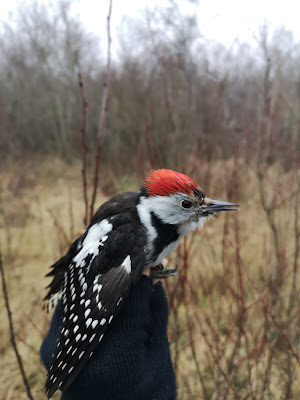 |
| Middle-spotted woodpecker |
 |
| Goldcrest |
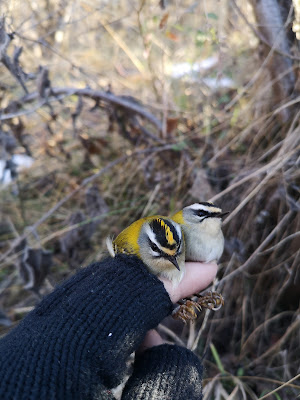 |
| Firecrests |
Friday, January 7, 2022
2021 Totals
The new year is upon us and it's time to analyze the results and achievements. For me personally, this was the most successful year in terms of the number of ringed birds and new species.
In this post, I'll include only the bird ring at my usual site in NW Bulgaria.
Most of the ringing was during the autumn migration, but I also put some effort into nest monitoring/ringing which gave good results(compared to previous years). Unfortunately, my nestboxes had very low success and I couldn't ring any Semicollared flycatchers (Ficedula semitorquata).
 |
| Yellowhammer (Emberiza citrinella) |
 |
| Turdus philomelos nest |
 |
| Sitta europaea nest |
 |
| Turdus merula nest |
| Male Turdus merula |
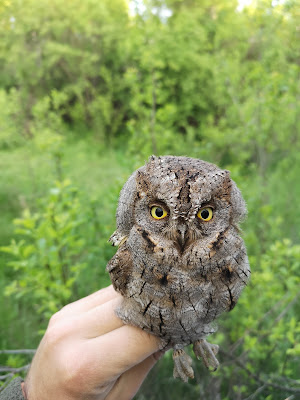 |
| Otus scops |
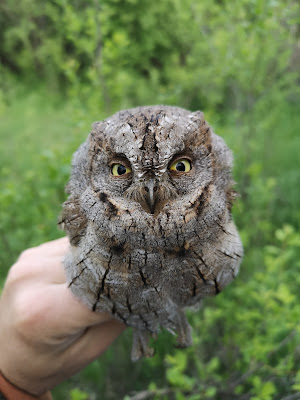 |
| Otus scops |
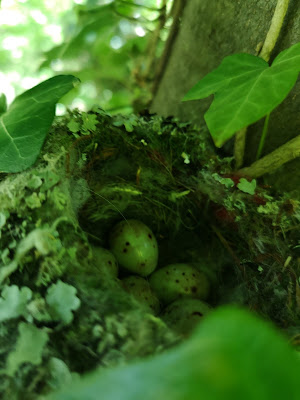 |
| Fringilla coelebs nest |
 |
| Turdus philomelos hatchling |
 |
| Parus lugubris hatchling |
 |
| Coccothraustes coccothraustes hatchling |
 |
| Cyanistes caeruleus nest |
 |
| Sylvia atricapilla nest |
 |
| Alauda arvensis nest |
 |
| Emberiza cirlus nest |
 |
| Lanius collurio nest |
 |
| Sylvia atricapilla hatchlings |
 |
| Lanius collurio nest |
 |
| Sylvia atricapilla nest |
 |
| Sylvia atricapilla hatchlings |
 |
| Lanius collurio hatchling |
 |
| Lanius collurio hatchings |
 |
| Male Lanius collurio |
 |
| Phylloscopus trochilus and Phylloscopus sibilatrix |
 |
| Phylloscopus trochilus and Phylloscopus sibilatrix |
 |
| Muscicapa striata |
 |
| Phylloscopus sibilatrix |
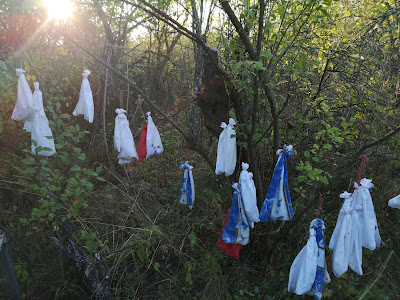 |
| Birds ready to be processed |
 |
| Male Sylvia atricapilla with very pale plumage |
 |
| Male Sylvia atricapilla with very pale plumage |
 |
| Merops apiaster |
 |
| Merops apiaster |
 |
| Erithacus rubecula |
 |
| Muscicapa striata with strangely colored legs |
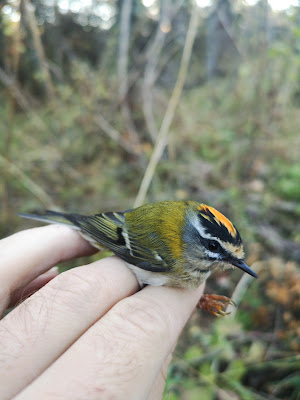 |
| Regulus ignicapilla |
 |
| Troglodytes troglodytes |
 |
| Parus major |
 |
| Male Coccothraustes coccothraustes |
 |
| Emberiza citrinella |
 |
| Chloris chloris |
-
This post won't be about birds ,but I think that it will be very interesting for all of you who love nature. Few days ago my brother sen...
-
This autumn I finally decided to dedicate some time to ringing winter thrushes( or at least attempts to do so) because my ringing results r...
-
I have a question ....Do you think that it is save to post information about bird traps. I have many schemes about traps ,but I haven't ...




